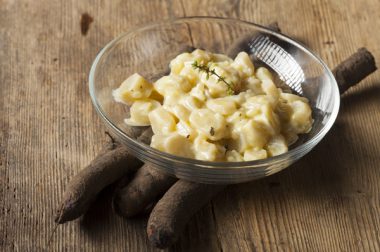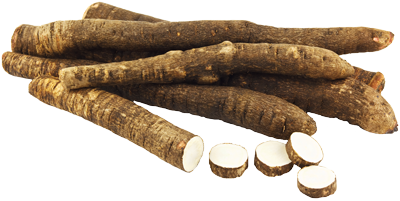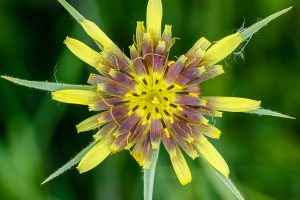Health
benefits
A good way to get lazy bowels moving
High in fiber and low in calories, salsify is an “intestinal broom.” It cleans without causing upset, giving it an excellent reputation and meaning that everyone, young and old, can tolerate it. It contains a soluble fiber, inuline, which supports the “good bacteria” of our gut microbiota.
It also contains :
- potassium: vital to maintain blood pressure
- vitamin B9 or folic acid: vitamin for pregnancy, childhood and adolescence
- vitamin E: antioxidant and cardioprotecteur
Nutritional
composition
When is the right
time to eat it?
Fall and winter
Salsify is harvested from October through March. It is very resistant to frost.
Vegetable patch or
urban balcony?
Salsify (Tragopogon porrifolius, from the Asteraceae family) is an herbaceous biennial that grows well in full sun, in sandy, well-drained, fairly light soil rich in humus.
To learn everything you need to know about growing salsify, read the page on growing advice.
Discover how to group vegetables according to plant families.
Choosing and
storing salsify
Choose your salsify well :
- Choose thin, firm roots rather than thicker ones.
Properly store your salsify :
- In the refrigerator: Four to five days in the vegetable drawer.
- In the freezer: after first blanching it.
Anti-waste tips
Did you know that salsify leaves are edible? You can add them to a vegetable soup, put them in a stuffing for a pumpkin, or add them to a quiche. They are also delicious sautéed in olive oil and garlic (like spinach), served with a small portion of poultry.
Think about the planet, and avoid food waste! Here’s aAll that you need to know about food waste. Fight food waste to:
- Save money;
- Protect the environment;
- Feed the growing global population.
What is the environmental impact?
The Product Environmental Footprint (PEF), a score established by Agribalyse*, tells us more! It takes account of all the phases in a vegetable’s life cycle: how it’s grown, the impact of its transport, the impact of its processing, and so on. The lower the score, the lower the environmental impact.
- Salsify, cooked: 0.14
- Steak, raw: 2.77
*Data taken from the Agribalyse database, which gives the environmental score of foodstuffs. This unique score is the average of 16 indicators, calculated using the European methodology PEF. It is not the same as an environmental label or “eco-score”.
CO2 equivalent: for 100g of raw salsify: 0.069 kg of CO2 eq, which is the same as g of raw steak or driving 276 m by car
Tips and
tricks
Salsify goes well with…
Salsify is a root vegetable whose mild, sweet flavor is comparable to that of oysters (hence one of its other names, “vegetable oyster”), asparagus, artichokes, or parsnips. It is well known as an excellent addition to soups, stews, and gratins, but can also be eaten cold with vinaigrette. Like carrots and pearl onions, salsify can be eaten glazed.
Raw: Try it with a bit of well-seasoned vinaigrette. Young salsify shoots are also delicious and have a taste reminiscent of endive.
Cooked: Salsify is a marvelous match for melted cheese. Top chefs have also brought salsify back into fashion, in fantastic pairings with truffles and scallops!
How to prepare salsify
There are two ways to do it:
- Either scrub it under cold water or peel it with gloves on,
- Or cook it first, making it easier to peel.
Sprinkle it with lemon juice once it is peeled, to avoid the coloration of the vegetable.
Can everyone
eat it?

Young children
It can be uncomfortable for babies to digest salsify. It is therefore better not to feed it to children before the age of 15 months. Introduce older children to salsify soup, an easy-to-make recipe.
And everyone else…
People with irritable bowel syndrome may experience discomfort when eating salsify. This is generally short-lived, and salsify may be gradually re-introduced when symptoms are light or during remission. If you do have IBS, we recommend that you see a dietitian to work out an adapted diet.
See plenty of other tips for encouraging children to eat vegetables
Where does it come from?
Origins and varieties
Origins
Belgium and the Netherlands are the main European salsify producers.
Varieties
Salsify is an oft-forgotten root vegetable, from the same family as endives, lettuce, and Jerusalem artichokes. It is creamy brown in color. There are several varieties, including the Giant Russian, the improved French White, and the Mammoth Sandwich Island.
Scorzonera or salsify? Both scorzonera and salsify belong to the Asteraceae family. Salsify is yellow with purple flowers. Scorzonera (Scorzonera hispanica), also called “black salsify,” is black with yellow flowers. It is less fibrous and more flavorful than salsify, and for those reasons is taking over in market stalls.



 Bell pepper
Bell pepper  Chard
Chard  Vegetable garden: growing lentil
Vegetable garden: growing lentil 










